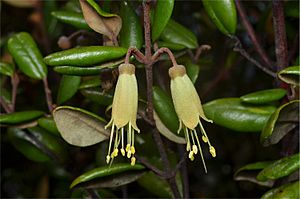Correa lawrenceana var. lawrenceana facts for kids
Quick facts for kids Correa lawrenceana var. lawrenceana |
|
|---|---|
 |
|
| In the Australian National Botanic Gardens | |
| Scientific classification |
|
| Kingdom: | Plantae |
| Clade: | Tracheophytes |
| Clade: | Angiosperms |
| Clade: | Eudicots |
| Clade: | Rosids |
| Order: | Sapindales |
| Family: | Rutaceae |
| Genus: | Correa |
| Species: | |
| Varietas: |
C. l. var. lawrenceana
|
| Trinomial name | |
| Correa lawrenceana var. lawrenceana |
|
| Synonyms | |
|
|
The Correa lawrenceana var. lawrenceana is a special type of Correa lawrenceana plant. It is found only in Tasmania, an island state of Australia. This plant is a shrub with unique papery leaves. It also has pale green, tube-shaped flowers. These flowers grow one by one at the ends of its branches.
Contents
Discovering the Correa lawrenceana Plant
This plant is a shrub that can grow up to 4 meters (about 13 feet) tall. Its leaves are papery and shaped like an oblong. They are usually 20 to 40 millimeters long and 3 to 30 millimeters wide. Sometimes, the underside of the leaves has rust-colored hairs.
Leaf Variations
Plants found in the northeast of Tasmania have narrow leaves. However, those from the south and west have wider leaves. These wider leaves often have hairy undersides.
Flower Details
The flowers grow alone at the tips of the branches. Each flower sits on a small stalk about 5 millimeters long. The calyx, which is the outer part of the flower, is cup-shaped. It is about 3 millimeters long and 4 millimeters wide. This part often has rust-colored hairs on the outside and a wavy edge. The main part of the flower, called the corolla, is narrow and tube-shaped. It is 15 to 20 millimeters long and pale green. Soft hairs cover the corolla. This plant usually flowers in the spring.
How the Correa Plant Got Its Name
The plant Correa lawrenceana was first officially described in 1834. This description was made by a botanist named William Jackson Hooker. He published his findings in a science journal called The Journal of Botany. Later, in 1855, William's son, Joseph Dalton Hooker, described another type of this plant. He called it Correa lawrenceana var. glabra. When he did this, it automatically created the name C. lawrenceana var. lawrenceana for the original plant.
Where the Correa Plant Grows
This specific type of Correa lawrenceana plant grows in forests. You can mostly find it in the mountainous areas of Tasmania. It also grows on King Island, which is part of Tasmania. Interestingly, this plant variety is also listed as growing in the Australian Capital Territory.

